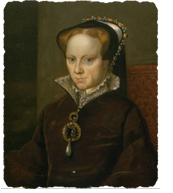

Mary became Queen in 1553 aged thirty-seven and talk quickly turned to a royal marriage. After securing her right to the throne Mary needed to produce an heir, preferably a boy.
As a young princess Mary had been an important political tool in forming alliances with foreign nations. At two years old Mary had been betrothed to the Dauphin of France. At the age of six, there were negotiations for Mary to marry her cousin the Holy Roman Emperor, Charles V. Other potential marriages were proposed as the political situation in Europe changed and new alliances were needed.
Although marriage negotiations were entered into, Mary’s illegitimate status and the uncertainty of her place in the succession hindered any serious marriage proposals.
Mary felt that it was her duty to marry and provide a Catholic heir to the throne. Parliament tried to persuade Mary that she should marry an Englishman. Edward Courtenay, Earl of Devon was proposed as a candidate. Mary rebuked Parliament for daring to interfere in her choice of husband declaring that they were ‘not accustomed to use such language to the Kings of England’. Mary could not consent to marry one of her own subjects.
Mary turned to Charles V, the Holy Roman Emperor for advice. Mary showed an interest in marrying Charles V himself, but he was suffering with ill health. Instead, Charles V proposed that Mary should marry his son, Prince Philip of Spain. Philip was already ruling Spain on behalf of his father and he was a Roman Catholic. Spain was one of the most powerful countries in Europe and so would be a useful ally. Henry VIII had sought the same political alliance when he married Mary’s mother Catherine of Aragon.
Parliament and the people of England were opposed to Mary’s plans to marry Philip. They did not want England subject to foreign rule. They were worried that the Habsburgs would have too much political influence and that England would be dragged into their European wars. If a son was born he would be heir to the throne of England as well as being a Spanish prince, leading to fears that England would become a province in the Spanish Empire.
Philip sent many expensive betrothal gifts to Mary, one of which was a magnificent pearl known as La Peregrina. Mary can be seen wearing this in her portrait by Hans Eworth, now hanging in the National Portrait Gallery. It was said that Mary treasured this gift above all others.
Mary and Philip were married in Winchester Cathedral on the 25 July 1554, the feast day of St James, patron saint of Spain. Mary was eleven years older than the twenty seven year old Philip. They had only met in person a few days before and Philip didn’t speak English, so they communicated in a mixture of Spanish, French and Latin.
The marriage treaty laid down many stipulations to try and limit Philip’s powers as King. While Philip could call himself King of England and help Mary govern he would have limited royal powers. Mary was to rule England and if she predeceased him Philip would have no claims to the throne. England was not to be involved in any Habsburg wars.
By the autumn, Mary’s doctors confirmed that she was pregnant. Mary went into confinement at Hampton Court Palace to await the birth of her child. Despite Mary showing several signs of pregnancy, by July 1555 it was obvious that they had been mistaken. Philip left for Flanders in August 1555 and didn’t return for eighteen months.
Continue reading with these recommended books (paid links)
The Terrible Tudors: Misery Mary (The Horrible Histories Collection)
 |
 |
 |
